Papers by Nina Wallerstein
T here is no one starting place, no single technique, no magic bullet for the development of rela... more T here is no one starting place, no single technique, no magic bullet for the development of relationships and partnerships with communities. For the purposes of this chapter, we define community as a group of people having a shared identity, whether it is based on geography; political affiliation; culture or race/ethnicity; faith; sovereign tribal nationhood; institutional connection, such as schools or workplaces; or shared group identification (Minkler, 2012; Minkler & Wallerstein, 2008; Rothman, 2008). Sometimes, when outside researchers ...

Strategies for Team Science Success, 2019
This chapter describes the potential for incorporating community partner perspectives into contem... more This chapter describes the potential for incorporating community partner perspectives into contemporary team science by recounting contributions made by community–researcher partnerships characteristic of community-based participatory research (CBPR). These CBPR partnerships look similar to cross-disciplinary academic teams in their histories and imperatives to create shared leadership, mutual benefit, and multidirectional trust and respect. First, we define and then situate CBPR within the range of community-engaged research practices and discuss the opportunities as well as challenges for CBPR and community-engaged research (CEnR) to become established within Academic Health Science centers and clinical translational science award (CTSA) infrastructures. We will share summary results of CTSA surveys about community engagement, from the academic perspective and from community perspectives on barriers they continue to face. An in-depth example will be shared of a successful community–academic partnership that grew from a pilot study to a large-scale clinical and population intervention center. We will end with a CBPR conceptual model that showcases how cross-disciplinary teams are needed to describe the richness of contexts in which research take place, to frame the development and use of measures and metrics to evaluate partnerships, and to identify promising participatory practices associated with research and health outcomes. Recommendations are provided for engagement of community partners within the cross-disciplinary team science enterprise.
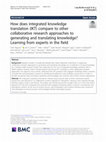
Health Research Policy and Systems, 2020
Background Research funders in Canada and abroad have made substantial investments in supporting ... more Background Research funders in Canada and abroad have made substantial investments in supporting collaborative research approaches to generating and translating knowledge as it is believed to increase knowledge use. Canadian health research funders have advocated for the use of integrated knowledge translation (IKT) in health research, however, there is limited research around how IKT compares to other collaborative research approaches. Our objective was to better understand how IKT compares with engaged scholarship, Mode 2 research, co-production and participatory research by identifying the differences and similarities among them in order to provide conceptual clarity and reduce researcher and knowledge user confusion about these common approaches. Methods We employed a qualitative descriptive method using interview data to better understand experts’ perspectives and experiences on collaborative research approaches. Participants’ responses were analysed through thematic analysis t...
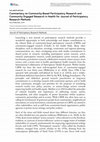
Journal of Participatory Research Methods, 2020
Launching a new journal on participatory research methods provides a wonderful opportunity to bot... more Launching a new journal on participatory research methods provides a wonderful opportunity to both acknowledge and deepen contributions to the vibrant fields of community-based participatory research (CBPR) and community-engaged research (CEnR) in the health fields. Many other disciplines, such as education, sociology, community and regional planning, communication, etc., share overlapping terms with similar commitments to shared power in research, including participatory action research, action research, participatory research, youth participatory action research, public involvement, practitioner research, collaborative research, citizen science, street science, and, a newer term in health, participatory health research, from the International Collaborative of Participatory Health Research. Within health, CBPR has been the most well-recognized form of community-engaged research for over thirty years (Wallerstein et al., 2018). Since 1998, it has operated with principles well-defined by Israel et al. (2013), and a widelydistributed definition launched in 2001 by the W.K. Kellogg Foundation. The principles and definition ground research practitioners in long-term commitments to co-develop research with community partners, and to build from community strengths and priorities for the purposes of translating research results into policy, practice, or system-change actions towards improving health and health equity. Minkler et al. (2012) added the principles of cultural humility and importance of addressing racism, sexism, homophobia, and other inequities of power hierarchies within academiccommunity partnerships and in society. While CBPR has often been seen as calling for involvement of grassroots people from communities, neighborhood associations, or social movements, community partners in CBPR can extend to other stakeholders, such as staff from community-based organizations, public agencies or private-sector settings, and policy makers. Each of the terms and fields named above have different histories, yet they are often divided into two separate traditions (Wallerstein et al., 2018). In the 1950s, Kurt Lewin defined "action research," often referred to as the Northern tradition, as a process of action/reflection/ action to engage teams of multiple stakeholders in research, predominantly for improving organizational settings (Lewin and Gold 1999). "Participatory research," often called the Southern tradition, emerged from activist scholars in the 1970s, drawing from the emancipatory philosophy of Paulo Freire (1970) to join forces with social Wallerstein, N. (n.d.).
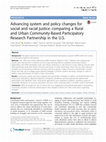
International journal for equity in health, Feb 21, 2017
The paper examines the role of community-based participatory research (CBPR) within the context o... more The paper examines the role of community-based participatory research (CBPR) within the context of social justice literature and practice. Two CBPR case studies addressing health inequities related to Type 2 Diabetes and Cardiovascular disease were selected from a national cross-site study assessing effective academic-community research partnerships. One CBPR partnership works with African Americans in rural Pemiscot County, Missouri and the other CBPR partnership works with African American and Latinos in urban South Bronx, New York City. Data collection included semi-structured key informant interviews and focus groups. Analysis focused on partnerships' context/history and their use of multiple justice-oriented strategies to achieve systemic and policy changes in order to address social determinants of health in their communities. Community context and history shaped each partnership's strategies to address social determinants. Four social justice approaches (identity/reco...
Journal of Mixed Methods Research, 2016
This article describes a mixed methods study of community-based participatory research (CBPR) par... more This article describes a mixed methods study of community-based participatory research (CBPR) partnership practices and the links between these practices and changes in health status and disparities outcomes. Directed by a CBPR conceptual model and grounded in indigenous-transformative theory, our nation-wide, cross-site study showcases the value of a mixed methods approach for better understanding the complexity of CBPR partnerships across diverse community and research contexts. The article then provides examples of how an iterative, integrated approach to our mixed methods analysis yielded enriched understandings of two key constructs of the model: trust and governance. Implications and lessons learned while using mixed methods to study CBPR are provided.

Qualitative Health Research, 2014
A national community-based participatory research (CBPR) team developed a conceptual model of CBP... more A national community-based participatory research (CBPR) team developed a conceptual model of CBPR partnerships to understand the contribution of partnership processes to improved community capacity and health outcomes. With the model primarily developed through academic literature and expert consensus building, we sought community input to assess face validity and acceptability. Our research team conducted semi-structured focus groups with six partnerships nationwide. Participants validated and expanded on existing model constructs and identified new constructs based on “real-world” praxis, resulting in a revised model. Four cross-cutting constructs were identified: trust development, capacity, mutual learning, and power dynamics. By empirically testing the model, we found community face validity and capacity to adapt the model to diverse contexts. We recommend partnerships use and adapt the CBPR model and its constructs, for collective reflection and evaluation, to enhance their p...
Page 1. New Approaches to Alcohol Interventions Among American Indian and Latino Communities: The... more Page 1. New Approaches to Alcohol Interventions Among American Indian and Latino Communities: The Experience of the Southwest Addictions Research Group Bonnie Guillory Duran, DrPH Nina Wallerstein, DrPH William R. Miller, PhD ABSTRACT. ...
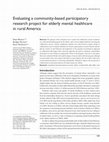
Progress in Community Health Partnerships: Research, Education, and Action, 2012
The purpose of this evaluation was to explore the collaborative nature of partners in a rural men... more The purpose of this evaluation was to explore the collaborative nature of partners in a rural mental health program for the elderly, and to test an adapted method of assessing the collaborative process. Sixteen collaborative partners were interviewed to explore ratings of collaboration across 6 domains identifi ed as critical to participatory research. Results indicate that the context of rural Missouri and uniqueness of the program necessitated an approach to collaboration that began with a top-down approach, but greater community responsibility developed over time. Partners recognized the efforts of the program's directors to seek input. Most were satisfi ed with their roles and the degree of success achieved by the program, although several wanted to have more input in the future in some domains, but not in others. Interviews revealed numerous barriers to achieving sustainability. Methods to improve the assessment of collaboration are discussed and areas for improvement are offered.
Journal of Public Health Management and Practice, 2002
Public health practitioners in Minnesota developed and implemented a population-based public heal... more Public health practitioners in Minnesota developed and implemented a population-based public health practice model for community assessment, program planning, and evaluation. The ultimate goal of this process is improvement in population health. Major challenges to the implementation of a population-based model are addressed through the use of a theory of action; interventions at community, systems, and individual levels; and intermediate evaluation indicators. Examples of resulting changes in public health practice are described.
Journal of Occupational and Environmental Medicine, 1994
ABSTRACT

The Journal of Early Adolescence, 2007
The Youth Empowerment Strategies (YES!) project is an afterschool empowerment program and researc... more The Youth Empowerment Strategies (YES!) project is an afterschool empowerment program and research project for underserved early adolescents. Central to YES! is an empowerment intervention that provides early adolescents with opportunities for civic engagement with other youth around issues of shared concern in their schools and neighborhoods. This article specifically focuses on the use of Photovoice as a promising way to engage youth in social change as they take photos capturing strengths and issues in their environment and use these as the basis of critical dialogue and collective action plans. Adding to a growing body of information on using Photovoice, this article reports how early adolescents in the YES! afterschool program experienced the Photovoice process, moving from photography and writing to initiate group-designed social action projects. Recommendations are offered for others engaged in empowerment work with early adolescents.
Health Promotion International, 2001
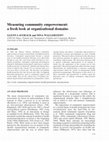
Health Promotion International, 2001
In 1986, the Ottawa Charter identified community empowerment as being a central theme of health p... more In 1986, the Ottawa Charter identified community empowerment as being a central theme of health promotion discourse. Community empowerment became a topical issue in the health promotion literature soon afterwards, though its roots also come from earlier literature in community psychology, community organizing and liberation education. Subsequent international conferences to address health promotion in Sundsvall, Adelaide and Jakarta have acted to reinforce this concept. It is as relevant today as it was more than a decade ago. The literature surrounding health promotion has since moved onto other overlapping theoretical perspectives, such as community capacity and social capital. And yet the critical issue of making community empowerment operational in a programme context remains thorny and elusive. Community empowerment is still difficult to measure and implement as a part of health promotion. This article offers a fresh look at key theoretical and practical questions in regard to the measurement of community empowerment. The theoretical questions help to unpack community empowerment in an attempt to clarify how the application of this concept can be best approached. The practical questions address the basic design characteristics for methodologies to measure community empowerment within the context of international health promotion programming. The purpose of this article is to allow researchers and practitioners to address again the important issue of making community empowerment operational.

Health Education Research, 2011
Community-based participatory research (CBPR) has been widely used in public health research in t... more Community-based participatory research (CBPR) has been widely used in public health research in the last decade as an approach to develop culturally centered interventions and collaborative research processes in which communities are directly involved in the construction and implementation of these interventions and in other application of findings. Little is known, however, about CBPR pathways of change and how these academic-community collaborations may contribute to successful outcomes. A new health CBPR conceptual model (Wallerstein N, Oetzel JG, Duran B et al. CBPR: What predicts outcomes? In: Minkler M, Wallerstein N (eds). Communication Based Participatory Research, 2nd edn. San Francisco, CA: John Wiley & Co., 2008) suggests that relationships between four components: context, group dynamics, the extent of community-centeredness in intervention and/or research design and the impact of these participatory processes on CBPR system change and health outcomes. This article seeks to identify instruments and measures in a comprehensive literature review that relates to these distinct components of the CBPR model and to present them in an HEALTH EDUCATION RESEARCH Pages 11

Health Education & Behavior, 1998
Although community capacity is a central concern of community development experts, the concept re... more Although community capacity is a central concern of community development experts, the concept requires clarification. Because of the potential importance of community capacity to health promotion, the Division of Chronic Disease Control and Community Intervention, Centers for Disease Control and Prevention (CDC), convened a symposium in December 1995 with the hope that a consensus might emerge regarding the dimensions that are integral to community capacity. This article describes the dimensions that the symposium participants suggested as central to the construct, including participation and leadership, skills, resources, social and interorganizational networks, sense of community, understanding of community history, community power, community values, and critical reflection. The dimensions are not exhaustive but may serve as a point of departure to extend and refine the construct and to operationalize ways to assess capacity in communities.
Health Education & Behavior, 2011
The purpose of this study was to develop a measure of community capacity for American Indian comm... more The purpose of this study was to develop a measure of community capacity for American Indian communities. The study included development and testing phases to ensure face, content, construct, and predictive validity. There were 500 participants in two southwest tribes who completed a detailed community profile, which contained 21 common items in five dimensions (communication, sense of community, youth, elders, and language/culture). In addition, subscales of women and leadership were included in one tribe each. Confirmatory factor analysis primarily supported the factorial structure of the instruments, and the seven dimensions were found to correlate with previously validated measures of social capital, historical trauma, community influence, and physical health in expected directions.
Community-Based Participatory Research for Health. San Francisco, Jossey-Bass, Nov 15, 2003
There are very real issues of race/ethnicity, racism and White privilege that every researcher, w... more There are very real issues of race/ethnicity, racism and White privilege that every researcher, whether White or a person of color, must consider when doing CBPR with communities of color. The trilogy of race/ethnicity, racism and privilege are underscored not because they are more important than other dimensions, such as social class or gender, but because they are often neglected areas of study. Privilege is one of the most important and difficult arenas for researchers to address, as it in part defines who we understand ourselves to be. To ...
American Journal of Public Health, 2011
Protocol approved was not required because no human volunteers were involved in this research.
American Journal of Public Health, 2008











Uploads
Papers by Nina Wallerstein
—racism, power, and privilege;
—trust development;
—ethical practice within and beyond IRBs;
—cultural humility; and many more.
Organized around the CBPR Conceptual Model, all new case studies illustrate the importance of social context, promising partnering practices, and the added value of community and other stakeholder engagement for intervention development and research design. Partnership evaluation, measures, and outcomes are highlighted, with a revised section on policy outcomes, including global health case studies. Appendices showcase new CBPR tools, in the text and through web-links, such as:
—Principles of CBPR and community-engaged research
—Data sharing and ownership agreements
—Community-based IRB trainings
—Government and foundation funding
—Evaluation instruments and tools
—Policy-analysis methods